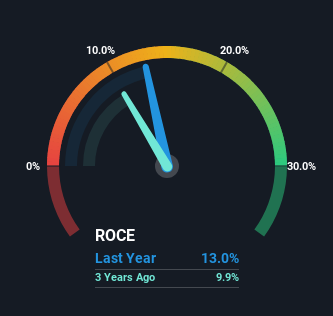Investors Met With Slowing Returns on Capital At Rogers Sugar (TSE:RSI)
If we want to find a potential multi-bagger, often there are underlying trends that can provide clues. In a perfect world, we'd like to see a company investing more capital into its business and ideally the returns earned from that capital are also increasing. If you see this, it typically means it's a company with a great business model and plenty of profitable reinvestment opportunities. Having said that, from a first glance at Rogers Sugar (TSE:RSI) we aren't jumping out of our chairs at how returns are trending, but let's have a deeper look.
Understanding Return On Capital Employed (ROCE)
For those who don't know, ROCE is a measure of a company's yearly pre-tax profit (its return), relative to the capital employed in the business. To calculate this metric for Rogers Sugar, this is the formula:
Return on Capital Employed = Earnings Before Interest and Tax (EBIT) ÷ (Total Assets - Current Liabilities)
0.13 = CA$95m ÷ (CA$961m - CA$229m) (Based on the trailing twelve months to September 2023).
Thus, Rogers Sugar has an ROCE of 13%. On its own, that's a standard return, however it's much better than the 7.6% generated by the Food industry.
Check out our latest analysis for Rogers Sugar

In the above chart we have measured Rogers Sugar's prior ROCE against its prior performance, but the future is arguably more important. If you're interested, you can view the analysts predictions in our free report on analyst forecasts for the company.
The Trend Of ROCE
Things have been pretty stable at Rogers Sugar, with its capital employed and returns on that capital staying somewhat the same for the last five years. This tells us the company isn't reinvesting in itself, so it's plausible that it's past the growth phase. With that in mind, unless investment picks up again in the future, we wouldn't expect Rogers Sugar to be a multi-bagger going forward. That probably explains why Rogers Sugar has been paying out 85% of its earnings as dividends to shareholders. Most shareholders probably know this and own the stock for its dividend.
The Bottom Line
In summary, Rogers Sugar isn't compounding its earnings but is generating stable returns on the same amount of capital employed. Unsurprisingly, the stock has only gained 33% over the last five years, which potentially indicates that investors are accounting for this going forward. As a result, if you're hunting for a multi-bagger, we think you'd have more luck elsewhere.
One final note, you should learn about the 3 warning signs we've spotted with Rogers Sugar (including 2 which are concerning) .
While Rogers Sugar isn't earning the highest return, check out this free list of companies that are earning high returns on equity with solid balance sheets.
Have feedback on this article? Concerned about the content? Get in touch with us directly. Alternatively, email editorial-team (at) simplywallst.com.
This article by Simply Wall St is general in nature. We provide commentary based on historical data and analyst forecasts only using an unbiased methodology and our articles are not intended to be financial advice. It does not constitute a recommendation to buy or sell any stock, and does not take account of your objectives, or your financial situation. We aim to bring you long-term focused analysis driven by fundamental data. Note that our analysis may not factor in the latest price-sensitive company announcements or qualitative material. Simply Wall St has no position in any stocks mentioned.
